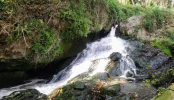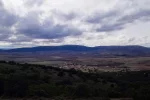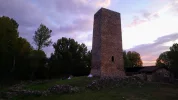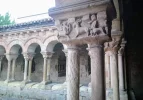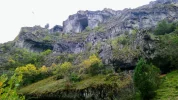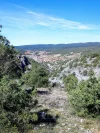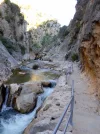- Time of past OR future Camino
- Except the Francés
Tudela to Tarazona
If coming from the south, most of the few people who walk the Castellano-Aragonés go from Gallur to Borja to Tarazona. I was coming from the north, and took advantage of the vía verde that goes all the way between Tudela and Tarazona. It's a lovely walk, once you're clear of the sprawling suburbs of otherwise beautiful Tudela. The Moncayo massif is straight ahead, slowly getting closer and more dauntingly huge. About half way is Santa María de la Caridad, the oldest Cistercian nunnery in Spain, partly 12th century, but all closed up when I went past.
Tarazona, nestling in Moncayo's foothills, is a delight - although the fast flowing Quieles, which bisects the town, was about half the size of when I went through four years ago. I was soon settled in the Galeón restaurant, where the menú included conejo de monte. Although sceptical about its provenance, I ordered it anyway and was just thinking "this is really good rabbit, but I still bet it's farmed", when I nearly broke a tooth on a piece of number 6 shot: so they weren't lying. It was washed down by a DO Borja Macabeo, quite oaky, very tasty, the first time I've ever had a Borja white. At 13.5%, rather strong for lunchtime.
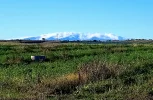
If coming from the south, most of the few people who walk the Castellano-Aragonés go from Gallur to Borja to Tarazona. I was coming from the north, and took advantage of the vía verde that goes all the way between Tudela and Tarazona. It's a lovely walk, once you're clear of the sprawling suburbs of otherwise beautiful Tudela. The Moncayo massif is straight ahead, slowly getting closer and more dauntingly huge. About half way is Santa María de la Caridad, the oldest Cistercian nunnery in Spain, partly 12th century, but all closed up when I went past.
Tarazona, nestling in Moncayo's foothills, is a delight - although the fast flowing Quieles, which bisects the town, was about half the size of when I went through four years ago. I was soon settled in the Galeón restaurant, where the menú included conejo de monte. Although sceptical about its provenance, I ordered it anyway and was just thinking "this is really good rabbit, but I still bet it's farmed", when I nearly broke a tooth on a piece of number 6 shot: so they weren't lying. It was washed down by a DO Borja Macabeo, quite oaky, very tasty, the first time I've ever had a Borja white. At 13.5%, rather strong for lunchtime.

Last edited:






